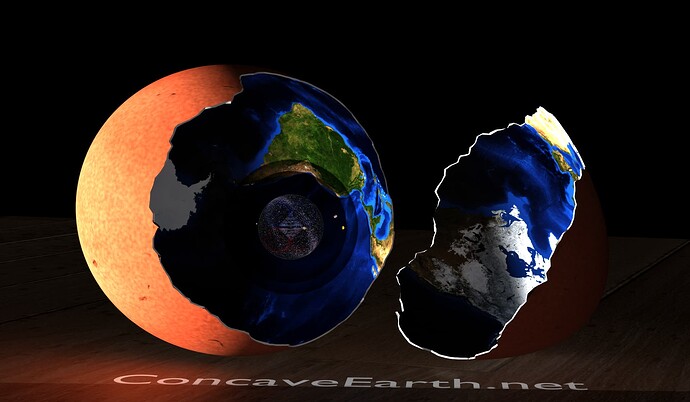The Nature of the Illusion in the Concave Earth Model
I. The Mathematical Foundation of Spherical Inversion
1. The Reciprocity of Inside and Outside
Spherical inversion is central to understanding how the apparent convexity of Earth arises within a concave Earth model. Using projective geometry and transformations by reciprocal radii, this mathematical framework demonstrates how lines and angles remain preserved under transformation, making reality appear convex even when it is concave.
Key Formula:
P’ = (R² / |P|²) ⋅ P
where:
R: Radius of the inversion sphere.|P|: Distance of the point from the center.P: Original point’s vector.
This mathematical consistency ensures that the optical illusion of convexity is maintained across various perspectives and instruments.
II. The Role of Light Bending in the Illusion
1. Atmospheric Refraction and Curved Light Paths
In the concave Earth model, light does not travel in straight lines but follows curved paths due to the varying refractive indices of the atmosphere. This upward bending of light creates a pseudo-convexity, making the horizon and celestial observations conform to the conventional understanding of a convex Earth.
Mechanism:
n₁ sinθ₁ = n₂ sinθ₂
where:
n₁, n₂: Refractive indices of the media.θ₁, θ₂: Incident and refracted angles.
As light propagates through denser to less dense layers (from the Earth’s “surface” outward), it bends upward, curving light rays to conform to a spherical appearance.
2. Measuring the Illusion
Mathematical instruments calibrated to assume linear light paths inadvertently measure a pseudo-reality. For example, astronomical measurements like parallax or the dip angle of the horizon can still be modeled mathematically within a concave Earth framework because the equations yield the same results when curvature is accounted for.
Examples:
- Dip Angle Formula:
Dip Angle = arccos(R / (R + h))
This holds true regardless of whether the surface curves inward or outward, as the refractive paths mimic straight-line propagation. - Parallax Measurements:
Curved light paths explain why distant stars appear to shift positions seasonally, mimicking the heliocentric model’s predictions.
III. Why Humanity Misinterpreted Reality
1. A Fallacy of Straight Light
The assumption that light travels straight has long underpinned scientific exploration. Optical phenomena such as the sinking hulls of ships or horizon dips are attributed to Earth’s curvature. However, in the concave Earth model, these are products of light bending upward, leading to the same observable effects but misinterpreted within a convex paradigm.
2. Apparent Convexity in Measurements
Mathematical proofs of the concave Earth emphasize how models based on assumptions of straight light cannot differentiate between true convexity and pseudo-convexity created by refracted light paths.
IV. Consequences for Scientific Observation
1. The Indistinguishability of Convex and Concave Frameworks
Instrument-based measurements do not inherently reveal the true geometry of space. Refraction simulates a convex appearance within the concave model, explaining the perceived uniformity in celestial mechanics and terrestrial navigation.
Impact:
- Gravitational Observations: Gravitational vectors in a concave Earth model are directed toward the inner shell, matching the observed effects attributed to Earth’s mass in the convex model.
- Optical Phenomena: Stellar aberration and eclipses occur consistently with refraction models within concavity.
2. Reevaluating Celestial Distances
The concave model reinterprets distances to celestial bodies through curved light paths, challenging the vast scales suggested by straight-line assumptions.
V. Conclusion: A Paradigm Shift
The concave Earth model invites a reevaluation of how humanity measures and interprets space. By acknowledging the bending of light and the inversion of perceived geometry, this framework explains why humanity has misinterpreted reality. It challenges conventional cosmological assumptions, providing an alternative view grounded in geometric inversion and refraction principles.
This understanding also emphasizes that scientific instruments and observations have been inherently constrained by assumptions of linearity, illustrating the profound implications of light behavior in defining our worldview. The realization of this error marks the precipice of a paradigm shift, urging a new exploration of cosmic structure.
